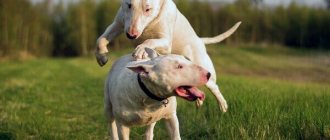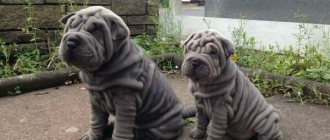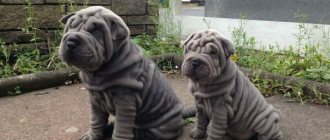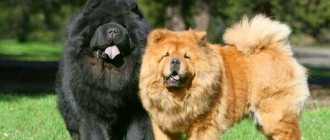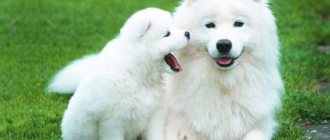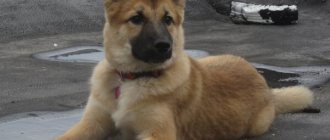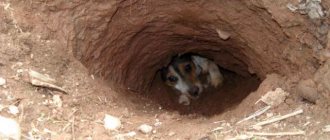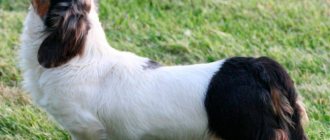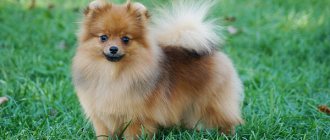Shar Peis were originally short-haired. Other types appeared after US breeders restored the breed in the 1970s after its almost complete destruction in its homeland, China. The communist government that came to power considered pets a legacy of the bourgeois past and mercilessly destroyed the animals.
In the late 1970s, Shar Peis were noted by the sad entry in the Guinness Book of Records: “The rarest dog breed.” The history of the breed could end there. To restore the population, American breeders used similar dog breeds, such as the Chow Chow, and the Shar Pei standard was adopted in 1976, based on new indicators.
What does an adult Shar Pei look like in the photo?
Shar Pei as a dog looks original and unusual . You will not find a similar breed. Such originality is achieved due to numerous folds on the dog’s body, especially on the muzzle.
They also have very short and coarse fur, which looks like velor.
A distinctive feature of this breed is its dark purple or lavender tongue..
The dog has a square body shape, a wide and strong back. Their neck is strong, well set on the shoulders, and their head is large in comparison with the proportions of the rest of the body. The Shar Pei's muzzle is wide, does not taper towards the nose, and the lips are visually full.
The breed's eyes have lowered eyebrows, which gives the impression that they are always frowning. Shar-Peis also have almond-shaped eyes. The animals' ears are small and set high. In appearance they resemble an equilateral triangle.
Shar Pei's tail is thick and curled into a ring..
Nutrition
This dog is quite picky about grooming. Due to poor nutrition, she may develop food allergies. Therefore, never treat her:
- Salty dishes.
- Smoked meats.
- Sweets.
- Sour berries.
- Bone fish.
It is better to abandon natural feeding altogether. The ideal option for an adult Shar Pei is dry fortified food. This diet is beneficial for the dog, as it contains all the substances that its functioning body needs.
If you are against ready-made diets and want to prepare homemade food for your pet, then adhere to the following rules:
- Do not treat him with raw food; preference should be given to food that has been heat-treated.
- Before giving food to your dog, make sure it is cool. Hot food can severely burn the animal's mouth and esophagus.
- It is better to stew the food you are going to give him.
- We recommend preparing porridge with meat and vegetables, as well as broths and soups cooked with the addition of bones.
- An excellent option is to add bone meal to the finished dish.
Breed standard
Characteristics of the breed standard :
- The dogs' height is 44-51 cm, and their weight is 18-35 years. Life expectancy is about 10-12 years.
- The head is powerful and large, folded. The folds do not cover the Shar-Pei's eyes and do not interfere with them in any way. Smoothly transitions into a dewlap around the neck. The muzzle is wide and without narrowing.
- Scissor bite. The teeth must be complete. The color of the palate, gums and tongue should be dark purple or lavender. Pigment spots on the tongue are allowed, but not completely pink color.
- The nose is black and large, the nostrils are open.
- The eyes are oval or almond shaped and should be dark in color. Their expression is calm; due to their overhanging eyebrows, they may be frowning, but no more; aggression or anger is not allowed.
- The body is square, the neck is strong, the back is wide. The harness should not interfere with the dog's movement.
- The limbs are powerful and confidently placed. Must be without folds. The feet are arched and the toe must be removed.
- The tail is thick and strong, curled into a ring.
Weight
The weight of these animals ranges from 18 to 25 cm, according to the standard. But in reality it can be much larger, first of all this applies to large and powerful males: Shar Pei weighing 35 kg or more are not uncommon among them .
IMPORTANT! The dog's weight should correspond to its height. A dog can be neither light nor too heavy.
Character and temperament
Despite its cute and funny appearance, this breed has a complex character that a beginner will not be able to cope with.
IMPORTANT!
This dog combines all the different character traits: a very high intelligence, good disposition, complete distrust of strangers, as well as excessive arrogance, which the dog can show not only to strangers, but also to family members.
This dog is very attached only to the owner, and treats children quite patiently . Nowadays, Shar Peis only show aggression under strong provocation or when the owner is in danger. The rest of the time they do not get cocky and do not go into open conflict.
Despite the fact that the dog is quite small in size, it can easily fend for itself and its family. The breed is devoid of blind aggression, which makes it an ideal watchdog.
Currently, the Shar Pei has become a companion dog that adapts to the course of a person’s life..
Price
Shar Pei is a rare and therefore expensive breed of dog. There is an excellent nursery in Moscow where its representatives are raised for sale. If you dream of becoming the owner of such a wonderful dog, we recommend going there for him.
The price of a sharpei with a pedigree is from 13 to 35 thousand rubles. It depends on the color, size, documentation, the presence of titles and prizes from the puppy’s parents and other important parameters.
Private breeders sell Shar Pei cheaper, from 10 thousand rubles. But when cooperating with them, do not count on purchasing an absolutely healthy and high-quality puppy.
Types and their descriptions (with photographs)
Today there are several types of Shar Pei. But the standard does not distinguish any separate types. Any dog that competes for the right to be called a Shar Pei must obey the description specified in the regulations.
American
There is still debate about whether the American variety of Shar Pei can be recognized on an equal basis with the Chinese.
“Americans”, unlike “Chinese”, are taller. They have long legs, representatives of this species are lean, and the withers are better defined.
Also, the American type is distinguished by a much smaller number of folds on the body. Their muzzle is more tucked up, the upper lip does not hang so low over the lower lip.
“Americans” have a smaller nose, and their eyes are clearly highlighted against the background of their muzzle . Among them, the most common are black or even monochrome individuals in color.
European
This type of breed was developed in Europe. Outwardly, it is very similar to its Chinese counterparts. The main changes occurred in the transformation of character.
The British, through long selection and crossing, obtained a dog that is most similar in character to the people of this country.
Such Shar-Peis are distinguished by even greater calm and almost complete absence of aggression. In this variety, the dog has turned from a watchman into an animal whose guarding skills have been dulled. European Shar Peis are phlegmatic, they prefer leisurely walks and are sedentary.
Over time, the dogs acquired a slightly different appearance than the original.
The structure of the body has changed, so in Europe they look much smaller than their counterparts, and the shape of the body has changed from square to more rounded, which once again emphasizes their inactive lifestyle.
"Bear"
These Shar-Peis are called so because of their incredible resemblance to a bear . They have a long, soft, fluffy, shaggy and flowing coat and are more similar to the Chow Chow than the Chinese variety.
The fact is that Chow Chows also took part in the restoration of the breed. Dogs with long hair appear due to the fact that the genes of a long-haired animal are expressed to a greater extent in an individual.
But this feature is considered a defect. “Bears” are disqualified from participating in exhibitions.
You won’t find such dogs in China, but in America, Russia or Europe they are not uncommon.
Many unscrupulous owners deliberately cut such Shar-Peis, turning them into “purebred” dogs for a while, but such manipulations are often discovered.
NOTE!
At dog shows, judges divide Shar-Pei dogs into varieties, but they almost always give preference to the Chinese Shar-Pei as the most suitable for the standard.
Main types of colors
The standard allows almost any coat color for this breed, except white. Spotting is also unacceptable.
- Black. This color is quite common for Shar-Pei, but representatives of this color are not always purebred. In many cases, the wool has some tint - olive, dark brown, brown or blue-black;
- Deer . This is the most ancient color, because it is no coincidence that Shar Pei is translated as “a dog with sandy hair.” The dog may be golden or sandy in color, but red is not allowed;
- Red . Also a very common color for Shar-Peis. This color can have different variations - from light red to rich red. The most fashionable and spectacular shade is mahogany;
- Red deer . These dogs have light red fur. Small whitish spots on the body are also allowed;
- Cream . The palette varies from milky to caramel. Cream-colored dogs are not white, although they are very similar. Because of this similarity, they are often confused, but cream dogs always have blackness near the nose and on the muzzle;
- Soboliny . In the standard, this color is specified as “zonal gray”. The Shar Pei's coat is of this color, as if with a gray coating, which to some extent extends to the face and limbs;
- Blue. This tone can be considered a weakened black. Shades can also be very diverse. They generally range from smoky gray to dark gray;
- Isabella . The color is considered very rare and complex. It has several tints - creamy pink, bluish or grayish. There must be a black mask on the face;
- Chocolate . This color also has a very large and varied palette - from the color of milk chocolate to the color of bitter and dark;
- Apricot . He is considered a weakened cervid. The dog has a golden-reddish coat, very warm and sunny;
- Lilac . Like Isabella, this is a rare color for the Shar Pei. It is very complex, the palette varies from chocolate with a certain pink undertone to warm pinkish blue or silvery pink with haze. On the face there is not a black, but a bluish mask.
Smooth-haired and long-haired
Shar-Peis are divided into two types based on their coat type.:
- Horse . The fur of this animal is more like bristles - short and hard, without undercoat. Its length barely reaches 1 cm in most cases;
- Brush . These dogs have elastic spines. It is much softer than that of Horses, it grows thickly, but there is also no undercoat. Brushes' fur is 1-2.5 cm long.
Since Shar-Peis do not have an undercoat, grooming and trimming of this breed is not allowed, because it can be harmful to the animal's skin.
Tongue color
In a Shar-Pei of the main color, the tongue can be exclusively blue-black; for a dog of dilute color, a lighter, lavender shade is acceptable. The color of the tongue is already visible in small puppies, although many of them are born with a lack of pigmentation. An adult dog's tongue should be spotless and one solid color.
Important! A pink tongue in a dog of this breed is considered a disqualifying fault.
Shar Pei is a dog whose character and appearance have been developed over centuries through the painstaking work of breeders. This dog has a number of specific characteristics that distinguish it from other breeds and make it unlike any other dog. All the features inherent in the Shar Pei were reflected in the standard of this amazing breed.
What do boys and girls look like and how are they different?
Externally, Shar Pei males and females are not much different.
This breed does not even have any special differences in height and weight in male and female genders. And if you have not dealt with Shar Pei representatives, then you are unlikely to be able to determine at first glance who is standing in front of you - a boy or a girl? However, there are still differences.
Most often, females are more elongated than males, that is, their body shape is more rectangular than square..
Despite the fact that there is no division by height and weight, females are often still slightly smaller than males. This feature is difficult to catch with an inexperienced eye.
Also, if the dog has already given birth, then the bitch can be easily identified by her belly: after giving birth and feeding, the previous fit of the bottom becomes more blurred, and without special training it can even sag.
Males look leaner and more muscular than females . They also differ in character to some extent. Males are possessive, more independent and disobedient. Bitches are flexible, they are much softer and kinder than males.
Thus, there are still differences between a Shar Pei boy and a girl, although not noticeable at first glance.
Appearance of puppies
Appearance of puppies at different ages:
- 1 month . At this age it is still too early to adopt a puppy into the family. He is still attached to his mother and other brothers, moreover, he still needs his mother's milk. A dog at this age is covered with many folds, which is why it looks touching. The legs are still short, as is the tail, which is too early to curl behind the back.
- 2 months . This is the age when you can already take a Shar Pei to your home. It's still covered in funny and cute folds, but they don't hang off it as much. The puppy has grown noticeably compared to last month. The legs have lengthened, and the tail is already curled.
- 3 months . This is the time to start training. The puppy has grown noticeably, the folds have become much smaller, only the eyebrows hang over the eyes, and the upper lip remains larger than the lower one.
- 4 months . A period of active growth. The puppy begins to socialize, at this time you need to start introducing him to other dogs. The folds still remain on the dog's body, but they are almost invisible. The proportions of an adult dog begin to be guessed in the pet.
- 5 months . The folds on the body are smoothed out and remain only on the face and withers. The dog becomes even larger, its legs lengthen. Puberty will begin soon, but in the meantime, your pet may begin to fight for the right to be the main one in your relationship.
- 6 months . The period of development of the puppy's personality continues. If the last stage was completed successfully, then now the dog will become incredibly loyal to you. The Shar Pei is becoming more and more like an adult animal. At this time, male dogs may begin puberty.
- 7-9 months . The dog's growth and weight gradually slows down. By 9 months, the Shar Pei has already fully acquired the appearance of an adult. By 8 months, female dogs may go into heat.
- 10-12 months . The final completion of growing up. By the age of one year the dog reaches its harmonious size. The psyche is also completing its formation. From this stage it will be difficult or almost impossible to retrain or re-educate the Shar Pei.
How to choose?
Choosing a puppy is always a responsible task, but when it comes to a Shar Pei, everything is very serious.
CAREFULLY!
If you have never encountered this breed before, it is better to take a specialist with you or carefully consult with him, because the range of risks when choosing a Shar Pei is large.
It is best to always buy a puppy with a pedigree, even if you do not plan for its show career. The fact is that when purchasing a puppy from your own hands, you run the risk of getting a “pig in a poke” with health and mental problems that will appear later, or even a mixed breed.
Check the availability of all documents and veterinary certificates . Also examine the puppy itself - it should be healthy, active, with clean mucous membranes and hair.
Be sure to look at how the puppies eat. The breed is prone to idiopathic enlargement of the esophagus, which is characterized by difficulty swallowing and excessive salivation. An examination by your veterinarian should be mandatory.
Keeping a Shar Pei at home
These pets are not difficult to keep. Despite this, there are some nuances that must be taken into account based on the breed characteristics of the dog. These are unique dogs, but they can pose a number of challenges when caring for them.
Care and hygiene
Since the dog's hair is short, caring for it is not difficult; it is enough to comb it once a week with a special brush. When the molting period begins, you will have to use a special mitten or furminator. This approach will allow you to get rid of hair in the house, and also deprive your pet of discomfort. The fact is that Shar-Pei's fur is quite hard and prickly, so it requires regular removal. Water procedures are optional, although a couple of times a year can be organized, although few of the individuals will be noticeably happy with water procedures.
Important to remember! Since the skin on certain parts of the body forms characteristic folds and dewlap, they also require special care. The folds on the face should always be wiped with a soft cloth after the dog drinks water. In addition, after eating, food remains in the folds, which also need to be removed. At the same time, you should not lubricate these places with ointments or sprinkle them with powders without consulting a veterinarian.
Naturally, you will have to take care of the cleanliness of your ears, for which you use cotton swabs. They are moistened in a special liquid, which is sold in veterinary pharmacies. Use cotton pads to clean the Shar Pei's eyes if dirt accumulates in their corners, as well as discharge from the eyes. If the dog has enough toys and the pet is given special treats, then additional teeth cleaning activities will not be necessary.
When a dog is walked, the claws wear down naturally if the dog walks on a hard surface. If this is not possible, then you can use a nail clipper. These dogs easily tolerate subzero temperatures, so they practically do not need additional clothing up to minus 20 degrees. If the temperature is lower, then a special overall will come in handy. It is advisable to keep these dogs in a house or apartment, since they are not very adapted to long stays in the cold. A demi-season overalls, which will protect your pet from dirt and other external influences, will also not hurt.
What to feed
The difficulty is that it is very difficult to choose the right diet for this dog. This is due to the fact that many Shar Peis suffer from intolerance to certain foods. Experts recommend choosing super-premium or holistic ready-made food for these pets. At the same time, feed is gradually added to the main feed, observing the behavior of the animal.
The option of feeding natural food is possible, given the fact that a pet eats up to 1 kilogram of various foods per day. Half of the diet should be lean meat, offal, and fish. The second half of the diet is formed by porridges prepared with buckwheat, oatmeal and rice. In addition, your pet’s menu should include fermented milk products, as well as vegetables and herbs.
Important! After purchasing a puppy, the basis of the diet should be those products that were used by the breeder to feed it. The transition to a dog's diet that is more convenient for the owner should be carried out gradually.
As a rule, small puppies are fed up to 6 times a day. The frequency of feedings is gradually reduced to 2 times when the animal reaches 1 year of age. The diet is formed based on the dog’s individual preferences, while those foods that the animal refuses or eats reluctantly are excluded from the diet.
Diseases and breed defects
This breed, like many others bred artificially, is predisposed to a number of hereditary ailments, such as:
- Shar Pei fever.
- Seborrhea.
- Demodecosis.
- Dermatitis.
- Hypothyroidism.
- Food allergies.
- All kinds of tumors.
- Dysplasia.
- Tight lip syndrome.
- Turning of the eyelids.
- Otitis.
It is important to know! If you successfully select a puppy and then provide it with comfortable living conditions, then a number of health problems for your pet can be avoided.
Breed defects
These problems include:
- Pink tongue and palate.
- Erect ears.
- Tail too short.
- Any body color, as long as it is not solid.
Training and education
Once born, Shar-Peis are characterized by autonomy and independence, so they need to be properly raised and socialized from an early age. These animals do not allow themselves to be treated with disrespect, always acting evilly towards their owner. Therefore, the process of education and training should not be accompanied by shouting and violence. Persuasion and affection are the main components that will help you get a positive result in raising such a pet. Only in this case will the dog make contact, understanding what his owner wants from him.
It is important to know! You should not allow the slightest signs of aggression, either towards the owner or towards members of the household, immediately stopping such behavior of the animal.
These dogs are capable of showing unmotivated aggression towards other dogs or animals. In this regard, walks with a Shar Pei should be carried out exclusively on a leash. To prevent an animal from showing aggression towards its own kind, this should be taken care of from an early age, accustoming the pet to the company of other dogs and other animals.
Correctly and competently organized processes of education and training always bring positive results. In this case, a loyal and devoted friend grows up for all family members, who does not show aggression towards strangers or other animals.
How to raise Shar-Peis
